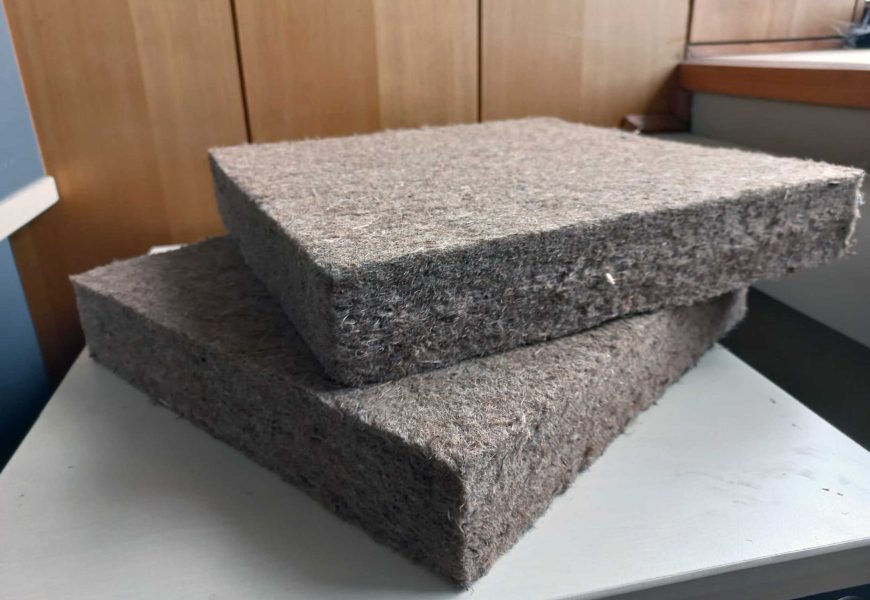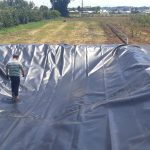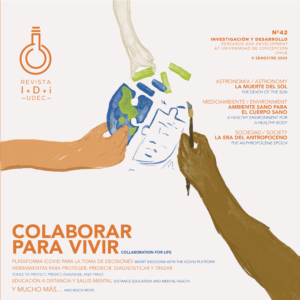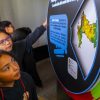By: Soledad Toledo Cabrera lucabrer@udec.cl | Photographs: Courtesy of AISLACOR
Leer en español
Forestry companies generate one particular byproduct in large quantities, eucalyptus bark, which is currently sold as biomass. Cecilia Fuentealba, Ph.D., a researcher at the Technological Development Unit (UDT UdeC), observed the characteristics of this byproduct, noting that it is a complex material from a logistical point of view and has a lower fuel efficiency than pine bark. However, it has a very advantageous feature, its fibrous morphology. Could anything be done other than burning it? Could it be turned into a new source of natural fiber? Could new value be given to this material?
Questions in the same vein haunted José Luis Sfeir, executive of the forestry company Collicura Ltda, who seven years ago joined the second stage of the Fondef IdeA project, which was born from the promising results that Dr. Fuentealba’s research team had obtained. The project ended with a prototype with a high feasibility of being scalable with a competitive price in the market for insulating materials. This result interested Sfeir because it is a product that allows the CO2 contained in the material to be captured and is a natural and environmentally friendly alternative.
“These panels are used as a thermal insulation material in homes, and given their versatile materiality, they could be used in other applications, such as doors and packaging,” said Sfeir. This is where the second potential impact of this technology appears. Currently, 99% of the insulation used in homes comes from fossil sources, such as expanded polystyrene, mineral wool, and glass wool, all with a high carbon footprint. Besides being competitive in price, UDT and Aislacor’s alternative is of natural origin and offers a sustainable solution to the construction sector.
“Nowadays, in Chile, there are no natural alternatives for thermal insulation materials,” said Dr. Fuentealba. “We are working with a byproduct with a low commercial value. This lowers the cost, and it has a high availability, something that does not always happen when looking for natural alternatives that are either seasonal or scarce. In addition, its availability makes it easier to be a scalable product,” he added.
Given its outstanding characteristics, the eucalyptus bark panel won first place in CORMA’s Madera 21 Competition in 2023, opening up great projections for the technology. “Productive activities that do not incorporate a sustainability approach are destroying our children’s planet,” Sfeir said at the event, adding, “We are betting on changing the way we produce and build, becoming more sustainable and cost-efficient.”
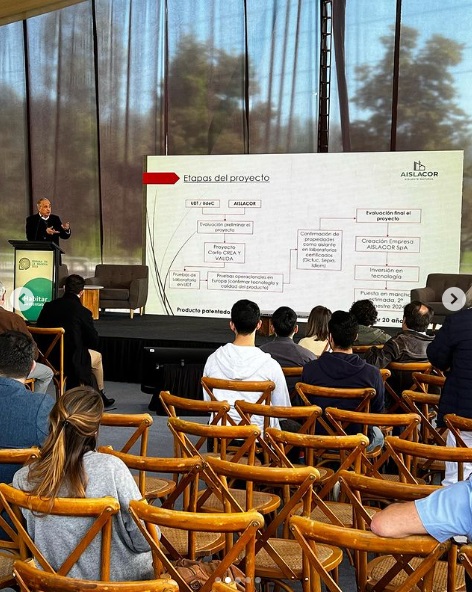
From the laboratory to the market
The new product reached a minimum viable prototype (MVP) development. For its launch to the market, it received Crea and Valida funds from Corfo, allowing the company to validate the product on an industrial scale and run tests with confidentiality from European partners. With these results, Sfeir and his partner Michel Esquerré created the spin-off Aislacor while the University of Concepción progressed with the patenting process. The result was a license agreement signed in 2023 between the company and the University.
“At this stage, the bridge between the company and the University is relevant as an articulator of the instruments that will allow bringing the solution to the market, concretizing innovation and its impact,” explains Andrea Catalán Lobo, Director of the Licensing and Transfer Office (OTL UdeC). This unit leads the process of negotiating and formalizing the license agreement from UdeC. As Catalan clarifies, it must “consider the value contribution of the technical solution developed at UdeC and the contribution of the productive and commercial capacities of the licensee company Asilacor, to generate a scenario of mutual benefit and a long-term collaboration.”
The commitment is to maintain the collaborative work between the company and the University. The panel has already passed the tests required by the MINVU, referring to thermal conductivity, acoustics, and fire resistance, which are necessary for use in the construction industry, with equal or better results than today’s products.
A circular economy that reinvigorates the industry
Aislacor is progressing in implementing and commissioning two complementary industrial plants to produce insulating panels. The first is in Santa Juana, and the second is in the old facilities of Bellavista Oveja Tomé, giving new life to the buildings of the textile companies in the area.
In this way, the thermal insulation panel technology will put a product on the market that is expected to be used in light-framed constructions, building partitions, and other wooden constructions. This will provide a sustainable solution incorporating the necessary aspects of circularity while respecting the environment.
“There comes a time when there are issues that, as researchers, we can no longer intervene in. However, we continue to work with the company, providing all the technical support they need, providing scientific backing, looking for links, and offering ideas on new uses and potential applications, which, of course, we can’t see now, but that are shaping up as future projects,” concluded Dr. Fuentealba.
Last modified: 3 de septiembre de 2025
